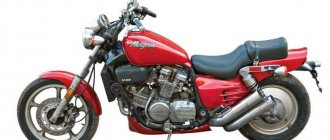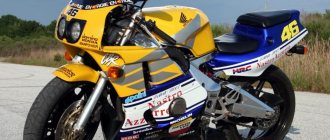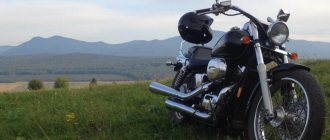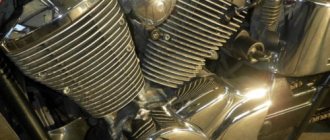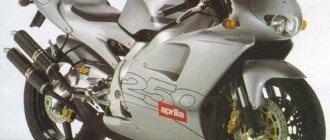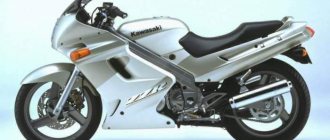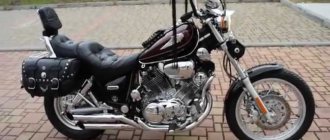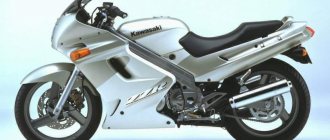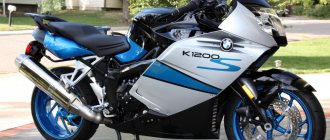Release history
6-speed gearbox, cardan, hydraulic clutch, short chopper frame, forward running boards. During this time, the model undergoes one restyling, but the main features remain recognizable.
The model pleasantly surprises at first glance - unlike many choppers, there is no flashy ostentation here.
In 1993, the third generation of the motorcycle was released, and the first thing to change was the chassis. A chain appears instead of a cardan, 6-speed gears change to 5, and according to user feedback, the brakes have to be modified.
The bike was produced for another 10 years , and in 2003 it was discontinued. The model has no successors, so despite its venerable age it is still in demand.
It is interesting that the export direction of development was reflected in the number of horses , and, accordingly, on all parameters that depend on this. The difference between the Japanese/European and American trim levels is 10 or more horses (the American has more).
Review of Honda V45 (1989)
Hello! In the summer you are stuck in traffic jams, and some “suicides” are rushing past you at “enormous speeds”. Where? Where? Why? Once upon a time there lived a degenerate, he bought himself a motorcycle and began to rush around the streets on it at night to wake everyone up with the roar of the engine, and during the day at a speed of 200 between the rows, so that in the end, of course, he would crash?... well, is everything really so sad and gone?
I, wandering about my business, went into a car dealership on Bolshaya Dmitrovka, seeing through the window one of my dreams - the AC Cobra. And so I walked around this work of art for one and a half hundred thousand greenbacks and asked the manager what and how (of course there was no money for it, but it’s interesting!). So, there is no stove in it, the awning and glass are attached using pins with which they are stuck into the carbon fiber body... And 4 seconds to 100 km/h... Adrenaline on wheels... “But what the hell,” I thought, “After all, I have there’s a motorcycle!” Also 4 seconds to 100, also without a stove - and it costs many times less! And, as a bonus, you don’t have to sit in traffic jams!
So, about the motorcycle. Why buy a motorcycle? There are maniacs who elevate them to a cult. I love my motorcycle, but still it is for me, and not vice versa. This is transport.
It all started with the fact that I was sitting in a Range Rover in a traffic jam and once again saw a scooter driver passing by. It was summer, I didn’t have a category “A” license, so I ordered a 100 cc scooter from Japan. It looks like a 50 cc, but it accelerates to 90 km/h from a hill, even up to 85 in a straight line... But the traffic cops don’t know that you need a license for it. And so, Moscow has shrunk, shrunk to the size of a provincial town. But everything turned out to be nearby! Half an hour - and you are on the other side of the city! But on the highway it’s just sickening. You won’t go to the dacha. It turns out to be a dilemma: it’s good in the city, but it’s hard on the highway - it’s boring to crawl at the same level as Kamaz trucks. Here's a Kamaz driving nearby. You can’t overtake, but it’s a shame to fall behind. It's sad. And by car along the highway you quickly reach Moscow - and you’re stuck in traffic jams... In general, I realized that I needed a motorcycle.
I opened category A and started the new season with a Magna V45, brought with a mileage of 5000 km from Japan. I took a chopper-shaped motorcycle with the expectation that it would not provoke dangerous maneuvers and because I love beautiful equipment... The engine is a V-shaped 4-cylinder, with a volume of 750 cubic meters, 77 horsepower (for America they were more powerful - 88 horses!). It is not very clear what class it belongs to. Either a cruiser or a dragster. I'm inclined to think it's a dragster. One of the few Japanese “choppers” that do not copy American classics (and a copy is usually something worse than the original). A kind of lean motorcycle with an engine from the sport-tourist Vifer. The drive to the wheel is via a cardan. According to the manual, maintenance is done every 15 thousand, in practice I change it more often. Cooling is liquid. I use 95 gasoline. And it eats well, if you drive fast, it can eat 10 per hundred, especially after I installed a dynajet in the carbs (and there are 4 of them), which increased the torque at the bottom. Now the revolutions can be kept about 1000 less (maximum revolutions - 10 thousand, normally pulls from 3 thousand, main operating speeds - 4.5-7 thousand revolutions). The tank is 13 liters. Yes, the gearbox is naturally manual, 6-speed. I had little experience driving a manual, so I had to get used to it. But on a motorcycle, mechanics are a blessing, because... it does not interfere due to the fact that the motorcycle is not stuck in traffic jams, but the absence of unexpected switches when turning is very desirable. The box works smoothly, neutral is caught without any problems.
In the first season I had an accident. I drove along a 4-lane road over a hill - and on you! Hyundai Jerboa is turning right under me through the solid road. He didn’t see me from behind the hill, just like I didn’t see him. And for whom did they draw the solid one??? I slowed down as much as I could, put the motorcycle down and flew head-first into his door, and the motorcycle under the wheel (there was nowhere to go to the right - a curb and a fence). The motorcycle had a worse situation: the headlight and dashboard were broken, the wing was crushed, the steering wheel was bent; I crushed the door with my helmet, only breaking my lips and getting a hematoma on my leg (the knee pad distributed the blow from the knee, otherwise I probably would have broken the joint)... I drew conclusions for myself. The next season I began to drive even more carefully and learned to use the brakes better. And I'm afraid of helmets without lower jaw protection. I bought the tidy used for 9,000 rubles, a new original headlight for about 400 bucks... The fender and steering wheel were straightened, the tidy mounts were welded with argon, and everything was screwed into place in the garage.
By the way, about the brakes. Magnas are often criticized for the fact that the brakes do not match the dynamics of the motorcycle. If you brake only with the front brake, this is indeed the case, but the rear brake, it feels like, adds 30 percent of the braking force during a sharp stop (although it can easily lock, which is not scary). The front wheel is difficult to lock. In general, the brakes are enough for me. Although this may be because after the purchase I installed a reinforced brake hose, and in addition to a motorcycle I ride an Escalade, so comparing brakes is always in favor of the motorcycle.
The Magna is long and low, so it doesn’t rear up spontaneously (although a professional in his field will probably bully it), and if you overdo it with gas on cold tires or just suddenly release the clutch, it leaves black streaks and grinds the asphalt with the wheel.
Thanks to the motorcycle, I was able to go to work while living in the country. In the morning traffic jams, along the Minsk highway, I got to the very center in an average of an hour - an hour or 10... The same goes back. And this is 90 km one way.
It’s just hard to describe how great it is to be transported from hot, stuffy Moscow into nature in an hour and have dinner at a table in the garden, listening to the birds singing and throwing pine cones into the samovar... I just got there by car - I immediately need to sleep... It’s long and hard.
But the car is dry and warm, many will say. But it turned out that rain is not a problem. I bought rain pants and a jacket, put it on over my equipment - and no rain is scary. I had to drive very often in the rain.
The traffic police officers, thanks to them, are loyal and, if they block the road (and I, of course, come along the aisle at the very beginning of the traffic jam), they usually allow you to pass if you ask... Up to 170 it handles well, after 170 vibration starts, and the wind blows strongly . On the Minsk highway I usually drive at a speed of 130-150, but such a ride is not very pleasant without wind protection. It is much more pleasant to drive on winding roads at a lower speed. The dynamics up to 100 are very good, around 4 seconds. With a passenger of about 6. In the city, I regularly made a comrade from traffic lights on a bandit with a volume of about a liter. But after 100 km/h the dynamics deteriorate.
Among the breakdowns - the carbs began to get clogged, either they put gasoline and sand in my tank, or the tank began to rust - but the needles sank and the carbs were flooded. As a result, after disassembling and cleaning the carbs, a gas filter was installed. There is a stupid story connected with this. On an empty road near Moscow, going from Kubinka to Zvenigorod, the needle in my carburetor apparently got stuck and the carbs were flooded. After suffering for some time this way and that, pouring gasoline from the carburetors, the engine was brought back to life, but the smoke was pouring out thick and white, like from an IZH. I jumped into the saddle and let him completely fuck himself. Everything unnecessary was burned out, the smoke disappeared and suddenly the motorcycle stalled... I stopped in complete disarray on the side of the road and began to think what to do, since I assumed that the carbs were to blame again... Luckily for me, guys were riding from the bike rally on choppers, who, like As is common among normal motorcyclists, they stopped and together with me began to look for a solution to the problem... When it turned out that I had simply run out of gas, I just felt like a complete idiot!! In general, everyone poured gasoline for me from their tanks and I was able to continue my journey. Guys, if you are reading this, THANK YOU again!
How does the motorcycle ride? In a car, you can relax behind the wheel and drive without straining... On a motorcycle, you can’t even for a minute! And attention should always be at its limit! Once you get distracted, the back of a car that is braking appears in front of you. But here’s the pattern: when driving a car you get tired not physically, but mentally - you’re constantly watching so that someone doesn’t rub you in, other road users are rude to you, there are outright psychos yelling something at you, waving their arms; they don’t let you through, they cut you off, you’re stuck in a traffic jam... You interfere with someone’s driving and cut you off inadvertently... In short, the seat is comfortable and there is air conditioning - but it’s morally difficult. But on a motorcycle everything is exactly the opposite: physically it’s harder, but mentally you don’t get tired at all, since they simply don’t have time to be rude to you, since you’ve already moved forward between the rows and are not stuck in traffic jams (in short, it’s like doing a little exercise). I didn’t understand before why they say that a motorcycle gives you a feeling of freedom. And now I understand. You go wherever you want. There are no problems with traffic jams, there are no problems with parking, you can drive into the forest along a path... By the way, the cross-country ability, at least geometrically, of the motorcycle is very good.
Have you ever had your mirrors knocked off by motorcyclists on purpose? This usually happens when a car does something that makes the motorcyclist feel the breath of death. And instinctively, since at such moments you do everything automatically, the motorcyclist can do something. Try to be in the place of a motorcyclist...
And so, by and large, if a motorcycle is seen when it is riding in the aisle, they not only do not interfere with it, but also move away so as not to interfere with its passage. For some reason, expensive cars behave especially politely... Inappropriate people who deliberately interfere with driving are rare. But sometimes there are those who want to spoil or even knock down a motorcycle with a specialist... Many of my friends note that the most harmful car for motorcyclists is the Renault Kangu. I don’t know why this is so, but somehow, while still on a scooter, I met a villain on Kangu... And once I was almost hit by a Honda Civic... A special guy tried to hit me. However, breaking away from the car on a motorcycle is not a problem, the dynamics allow it. At the same time, sportbikes leave me no chance - they go “to the point.”
Having ridden a motorcycle, you understand that rudeness and jostling in traffic jams for the right to be one or two lengths ahead is complete idiocy and makes no sense! All the same, everyone stands, stands, and stands...
The rear suspension has two shock absorbers, which are adjustable for preload in five positions. I’m comfortable in any position, but until I made it harder, passengers complained about tooth-crushing suspension breakdowns.
In a secluded place on the motorcycle there is a small box with a set of tools, which is very useful.
The lack of wind protection is rather a plus for me; I didn’t install glass on purpose. In cold weather, you can dress warmly, and in hot weather, the oncoming air flow is pleasant.
The disadvantages of the motorcycle include a small tank (it is very inconvenient to refuel twice a day when living in the country) and the specific location of four mufflers sticking out at an upward angle. This eliminates the possibility of hanging side panniers, and the central pannier on such a motorcycle will look ugly.
Also, I don’t really like the revving engine, which provokes me to step on the gas and drive. But these are my personal views, many people like twisting motors.
I bought a Harley in the winter, but I want to keep the Magna unless I need to sell it for financial reasons, because I like it.
My opinion: a motorcycle is a worthwhile, necessary and useful thing, but without experience in driving a car, you should not start riding a motorcycle. It’s better by car, with the right to make mistakes, to study traffic and the behavior of drivers (for example, there is a place in my area where everyone from the left lane turns right without a turn signal, and from the right lane they always drive straight. I already know this trick and there’s no one there I'm not trying to overtake). And then, when you have experience driving a car around the city, you should get on a motorcycle. And if you buy a motorcycle, be sure to buy equipment, and don’t even get on it without a helmet!
Drivers! Be polite to each other and be considerate of motorcyclists. It's easy to accidentally knock them down...
Specifications
The famous Honda V4 is an extremely reliable, time-tested and polished unit.
As users say, the motorcycle’s power plant is from Vifer. Honda VFR750 sports tourer model.
The bike became the first cruiser to receive a V-shape. The motor turned out to be so successful that they did not reconfigure it. This is a conventional 4-cylinder, 4-stroke liquid-cooled engine.
Users note the use of 95, but at the same time add: “ any, only without sand, the carbs get clogged .”
| Honda Magna 750 | Parameter |
| Motorcycle type | cruiser |
| Year of issue | 1982-2003 |
| Frame | steel tubular |
| engine's type | 4-cylinder, 4-stroke liquid-cooled engine, V-shaped, 748 cm³, 72 hp. |
| Number of valves per cylinder | DOHC, 4 valves per cylinder |
| Fuel supply system | Carburetor |
| Ignition type | CDI - 1982-1986, transistor - 1987-2003 |
| Transmission | 5-speed manual transmission - 1993-2003, 6-speed manual transmission - 1982-1992 |
| type of drive | cardan – 1982-1992, chain – 1993-2003 |
| Maximum speed | 196 km/h |
| Gas tank capacity | 13.0 l – Magna 750 (1987-2003), 14.0 l – Magna 750 (1982-1986) |
| Power reserve | 200 km |
| Motorcycle weight (curb) | 242 kg – Magna 750 (1982-1992), 245 kg – Magna 750 (1993-2003) |
| Acceleration to 100 km/h (0-100 km/h) | 4.3 sec |
| Comfortable cruiser | 120 km/h |
Transmission and clutch
Chain drive – 1993-2003.
Cardan drive – 1982-1992.
The engine is equipped with a 5-speed gearbox (until 1993 - 6 steps ). There were no complaints about the boxes, so this modification only raised questions.
- In models of the first 2 generations : hydraulic clutch, cardan drive.
- The last 10 years have been a cable clutch, and the main drive has been a chain .
Brakes
The generations have not affected the rear drum brake in any way. A motorcycle of any year of manufacture has a standard drum.
Front brakes.
Rear brakes.
But they worked on the front wheel rims at every shift. However, the support in all variations remained the same - a hydraulic bracket with 2 pistons .
- 1982-1987 - 275 mm, 2 disks;
- 1987-1993 - 275 mm, 1 disc;
- 1993-2003 - 315 mm, 1 disk.
No additional systems such as ABS were provided.
Comparison of 1983 and 98 Honda Magna 750
In this article I would like to compare the 1983 Honda Magna 750 V45 with the 1998 Honda Magna VF750C. The 1983 Magna is the bike I owned and rode for four years. The 1998 Magna is my bike today and I've been riding it for over a year now. Some might think it's unfair to compare bikes that are as much as 15 years apart in age, but maybe they're right. I have been riding motorcycles since October 1997. This is not much of an experience compared to other motorcyclists. And besides, I’m not one of those who is well versed in hardware. Apart from basic procedures such as periodic oil changes, replacing light bulbs and batteries, I prefer not to go deep and not understand the mechanical structure of my bike. On the contrary, before I go myself into something I don’t know how to do, I would rather try to find professionals and entrust the work to them.
No, my friend, my passion is RIDING! Apart from the many positive aspects of motorcycling, and there are many, the thing that appeals to me the most is riding a motorcycle. After driving my old Honda Magna for four years and upgrading to a newer Magna model, I feel like RIDING in the Magna has improved significantly. I'll try to explain why.
In this article I would like to compare the 1983 Honda Magna 750 V45 with the 1998 Honda Magna VF750C. The 1983 Magna is the bike I owned and rode for four years. The 1998 Magna is my bike today and I've been riding it for over a year now. Some might think it's unfair to compare bikes that are as much as 15 years apart in age, but maybe they're right. Indeed, technology, design and quality control have changed significantly over the past 15-20 years. My goal was simply to explain what I felt and what differences I found between the old V-4 (1982-1986) and the new V-4 (1994 - 2003) models... nothing more. First, let's take a look at the specifications of both models:
| Model: 1983 Honda VF750 Magna V45 | Model: 1998 Honda VF750C Magna |
| Final drive: DOHC 4-valve, 90-degree camber, four-cylinder ;V-Four; | Engine: DOHC 4-valve, 90-degree camber, four-cylinder; V-Four; |
| Displacement: 748 cc | Displacement: 748 cc |
| Transmission: 6-speed | Transmission: 5-speed |
| Seat height: 32.0 inches. | Seat Height: 28.0 inches |
| Main gear: Cardan | Final drive: Chain ;O-ring; |
| Cooling: Liquid | Cooling: Liquid |
| Brake system: two discs at the front, drum at the rear | Brake system: single disc front, drum rear |
equipped with the same type of equipment, engine protection, footpegs, etc., and both motorcycles had standard equipment regarding the engine. In addition, the 1983 Magna was additionally equipped with the state-of-the-art “Dave Dodge 15-minute Oil Mod Kit.” Now, even taking into account their similarities in parameters, they are nevertheless very different in three criteria: ride, maneuverability and power.
Ride: When I rode my 1983 Magna, I sat in a 32-inch saddle. I had nothing to compare it to at the time, but when I rode a 1998 Magna provided to me by a Honda dealer, I immediately noticed a huge difference between the 32 and 28 inches. The old Magna was much more difficult to steer, especially given its short wheelbase, I immediately felt how much more pleasant and comfortable the new Magna was to drive. In addition, the ride of the new Magna seemed much smoother and more confident to me. In my opinion, this is a consequence of the improvement of suspensions in the period from 1993 to 1998.
Maneuverability: The new Magna differs from the old model not only in its small stature, the old Magna is also wider than the new one, so the lower center of gravity and dimensions of the new Magna contribute to its better handling. Turning is carried out with less stress for the driver. The new Magna feels more balanced, especially when starting and stopping. Driving my new Magna through the Texas Hill Country, I found that corners can be taken at higher speeds and twisty routes are handled more smoothly and reliably. The new Magna makes cornering easier - less effort is required, as if the bike is doing all the work for you:
Power: There is a definite difference between the two models in question in terms of power. Note that the old Magna has a driveshaft as the final drive, while the new one has a chain. It's no secret that a chain transmits torque to the rear wheel more efficiently than a cardan. In my estimation, this is what makes the difference... hands down! Yes, the chain is something disturbing. It often needs to be checked, lubricated and tightened, but for me personally, all this turned out to be not nearly as burdensome as I first thought. I purchased and installed a ScottOiler automatic chain lube, which now takes care of the chain lubrication itself. All I do is check the chain tension from time to time and adjust it when necessary. And of course, I sometimes have to wipe the rear wheel rim to remove excess lubricant that gets there from ScottOiler.
Finally, let me address a couple of negative reviews I've heard about the new Magna.
The first was the seat. As soon as I bought the new Magna, it seemed to me that now I would have to buy a more comfortable seat, and that would be another 300 - 450 dollars. I've heard from other new Magna owners that the standard seat is extremely uncomfortable on long trips. In the end I decided to wait, try the stock seat and come to my own conclusion. I spent 8 hours on the road driving the new Magna, stopping only for gas. I've driven over 5,000 miles in total and found no reason to find the standard seat uncomfortable. If you're upgrading to a new Magna, try the stock seat first before committing to a Mustang or Corbin. This can save you from unnecessary expenses.
The second was the volume of the fuel tank. The total volume of fuel, including reserve, that fits into the tank of the new Magna is 16.34 liters. (3.6 gallons). The main tank holds only 12.7 liters (2.8 gallons). The average distance a motorcycle travels on 4.5 liters of fuel is 67-72 kilometers (42-45 miles). As a result of simple calculations, you can find that the new Magna is capable of driving approximately 250 km (160 miles) without refueling. Without switching to reserve, you can travel 160-190 kilometers (100-120 miles). For some riders, this is unacceptable, especially considering the fact that the old Honda V65 (1100 cc) can travel up to 257 km. (160 miles) before switching to reserve. For me, a distance of 160-190 kilometers turned out to be just optimal because when traveling, I prefer to stop after 150-200 kilometers for a short rest. In my new Magna, I have already traveled several times, once over 3,200 kilometers and once beyond 1,600 km, and I have never encountered any problems with the fuel limit at 160-190 km. I observe optimal fuel consumption at a speed of approximately 77 km/h. I managed to drive 183 kilometers before switching from the main tank to the reserve tank.
Before I finish, I want to draw your attention to some important facts that testify to the benefit of riding a bike with friends, or just a group. Riding alone is good, but riding with a group can greatly improve your driving skills and make your riding safer. Personally, I get great pleasure and satisfaction from riding in a group with friends. With each trip I learn a lot of new things and each time I significantly improve my motorcycle driving skills. If you're not part of a motorcycle crowd, find one! Communication with people and mutual assistance are invaluable. ;))
by Robert E. Hilliard https://www.tyler.net/tyr7020/palandme.htm
Driving characteristics (dynamics, acceleration)
A sufficient number of horses under the tank of the motorcycle allows you to move off dynamically and confidently accelerate from 100 km/h.
According to the developer's specifications, the maximum speed is 196 km/h . The owners note that at 160 km/h the wind begins to blow, but the power reserve is felt, so 190 is quite possible. Therefore, a comfortable cruiser is 120 km/h .
Acceleration from zero to 100 km/h in 4.3 seconds . According to user reviews, if we do not forget that this is a cruiser, for which sedate, leisurely driving is considered more normal, the performance is beyond praise.
Fuel consumption
According to the manufacturer's documentation, consumption is 2.63 to 4.52 liters per 100 km. But these are Japanese data. Owners in the Russian Federation note that you are unlikely to see anything below 5 liters. And if you anneal it, then all 10 liters .
The final result depends on your riding style. 13 liter tank means a mileage of no more than 200 km on one fill-up .
Review of the Honda Magna 750 motorcycle
I opened category A and started the new season with a Magna V45, brought with a mileage of 5000 km from Japan. I took a chopper-shaped motorcycle with the expectation that it would not provoke dangerous maneuvers and because I love beautiful equipment... The engine is a V-shaped 4-cylinder, with a volume of 750 cubic meters, 77 horsepower (for America they were more powerful - 88 horses !). Basically, it's a dragster. A kind of lean chopper with an engine from the sport-tourist Vifer. The drive to the wheel is via a cardan. According to the manual, maintenance is done every 15 thousand, in practice I change it more often. Cooling is liquid. I use 95 gasoline. And it eats well; if you drive fast, it can consume 10 per hundred, especially after installing a jet kit in the carbs (and there are 4 of them), which increases the torque at the bottom. Now the rpm can be kept about 1000 less. (maximum revolutions - 10 thousand, pulls normally from 3 thousand, main operating speeds - 4.5-7 thousand revolutions) Tank - 13 liters. Yes, the gearbox is naturally manual, 6-speed. I had little experience driving a manual, so I had to get used to it. But on a motorcycle, mechanics are a blessing, because... it does not interfere due to the fact that the motorcycle is not stuck in traffic jams, but the absence of unexpected switches in a turn is very desirable.
By itself, my motorcycle is low and long, so it doesn’t rear up on its own (although a professional in his field will probably bully it), and if on cold tires I overdo it with gas or just suddenly release the clutch, it leaves black stripes and grinds the asphalt with the wheel.
Thanks to the motorcycle, I was able to go to work while living in the country. In the morning traffic jams, along the Minsk highway, I got to the very center in an average of an hour or an hour or 10... The same way back. And this is 90 km one way.
It’s just hard to describe how great it is to be transported from hot, stuffy Moscow to nature in an hour and have dinner at a table in the garden, listening to birds singing and throwing pine cones into the samovar... I just got there by car - I need to go straight to sleep... It’s long and hard.
Among the breakdowns, the carbs began to become clogged, either they put gasoline and sand in my tank, or the tank began to rust, but the needles sank and the carbs were flooded. As a result, after disassembling and cleaning the carbs, a gas filter was installed and the problem disappeared. There is a stupid story connected with this. On an empty road near Moscow, going from Kubinka to Zvenigorod, the needle in my carburetor apparently got stuck and the carbs were flooded. After suffering for some time this way and that, pouring gasoline from the carburetors, the engine was brought back to life, but the smoke was pouring out thick and white, like from an IZH. I jumped into the saddle and let him “shit” to the fullest. Everything unnecessary was burned out, the smoke disappeared and suddenly the motorcycle stalled... I stopped in complete disarray on the side of the road and began to think what to do, since I assumed that the carbs were to blame again... Luckily for me, guys were riding from the bike rally on choppers, who, like As is common among normal motorcyclists, they stopped and together with me began to look for a solution to the problem... When it turned out that I had simply run out of gas, I just felt like a complete idiot!! In general, everyone poured gasoline for me from their tanks and I was able to continue my journey. Guys, if you are reading this, THANK YOU again!
I bought my Magna completely by accident. Initially I wanted to take an old Golda, but her owner never deigned to bring her back to normal, and I made an advance payment back in February. In April, I accidentally saw a motorcycle in a service center in the same form - the frame was under the wall, the engine was lying nearby, all the accessories were on the shelves and corners. And then the season opened and we had to figure something out quickly. A friend of mine just brought motorcycles for sale and I went to look. Among the motorcycles that arrived to him was a black Magna vf750, produced in 2001 with 89 horses. The motorcycle looked quite attractive, it had new tires, all the consumables were changed (they were changed at my request), the chrome was corroded by rust in some places, but everything else was in order and worked. I decided to take it, until that moment I had only driven sports - before Magna I was running around on a 919 razor.
The first impressions made me very happy - the motorcycle handled very well. Handling is classic. The center of gravity is low, the front wheel is not very far forward, which makes the motorcycle nimble; in general, it is very comfortable to ride in the city. The bike copes with traffic jams no worse than sports. There are no brakes. After the reinforced hoses were installed, the situation improved a little. The advantage is that you can ride safely and not be afraid of the front wheel slipping. In choppers, when the front wheel falls off on a straight line, Magna stupidly continues to slide forward. In short, some kind of attraction. After sports, such things are very relaxing, you won’t get that high there. Here, even in a turn, breaking the front does not threaten you with a fall, the main thing is not to get too full.
As for the seating position, it is comfortable, the saddle is comfortable, but the pegs with a specific forward reach bothered me quite a lot. In principle, I don’t like the choppy position, it’s completely unnatural, plus it severely limits movement, which is not good when driving a motorcycle. It is not very convenient to change gears with your leg extended forward - sport or classic in this sense are much more convenient. It is generally impossible to stand up on the steps, and therefore, moving over potholes and bumps, even small ones, causes pain in the spine. Such a motorcycle is completely unsuitable for long-distance driving - it is purely urban transport.
The engine is a good 750 cc, exactly like the one on the old Vyfer. It starts a little sluggishly, I was really a little spoiled by the more powerful engine. Basically, this is an ideal engine for beginners. It drives the same in any gear, not capricious and reliable - what more do you need?
Having driven the bike into my garage, I cleaned all the rust from the chrome, changed the oil in the fork - I filled it with a harder one, replaced the handles on the steering wheel - I installed ones that were comfortable for me. I also wanted to screw on the back and glass, but a friend really liked the bike, so before I had time to do this, he took it for himself and drove it for three seasons, of course.
Now, I almost forgot, there’s almost no light, there’s a tiny headlight, so why the hell change this kind of equipment for something more sensible. Okay, no problem with that now. The fuel gauge is also missing - instead there is a small light bulb. The tank is small, but this compensates for the moderate fuel consumption.
In general, the motorcycle is very beautiful, there is some kind of zest in it, or something. Good for beginners, even suitable for a girl, due to its low seating and ease of control.
I've been riding a Magna for the 3rd season. Well, what can I say... In terms of dynamics and power, it easily tears up any chopper-liter (and even more!) Provokes unscrewing. Good weight - not big and not small. Steering is not bad. (relative to other chopper-like ones) The seating position is quite comfortable -closer to the classic. (you can stand up on the steps on the pits) These are advantages. Of the disadvantages: a child’s tank (boils) and not a child’s appetite (if you fry it). Chain (universal shaft, of course, less gimmorous) The layout is dense (4 kule boilers...) Brakes (or rather the lack thereof) But... For me, Magna is like a beloved woman! You know all the shortcomings, but you forget about them in bed (on the road) where she is a HURRICANE!!! In general, I love her!!!
I'm not going to change this pepelats yet. Last season I installed roll bars, 70-liter panniers and a windshield. For this season, I boiled the tank down to 22 liters and installed a reinforced hose on the front brake. Happy as an elephant))). Now we need to come up with something with the rear shock absorbers, because... They have a very short stroke and sometimes leak when fully loaded. In general, only positive impressions. A very reliable device that can be used as a cruiser. I really like the handling, it handles almost like a classic! No breakdowns were noted.
Go to the Honda Magna 750
Check out the test drives:
- Review and test drive of the Honda VF750 Magna from Za Rulem magazine
- Review and test drive of the Honda VF750 Magna from Motorreview magazine
- Test drive Honda VF750 Magna from Motorreview magazine
- Test drive Honda VF750 Magna from Motorreview magazine
- Test drive Honda VF750 Magna from Motorreview magazine
- Test drive Honda VF750 Magna from Motorreview magazine
Modifications
No official modifications were made based on the motorcycle. But if you remember the third generation, which completely changed the chassis, it can be considered a variation.
Over the many years of production, the motorcycle changed colors several times.
and competitors
Despite the fact that the Honda model has long been considered a standard cruiser, competitors failed .
Only Yamaha . Its road bike FZX 750 , born in 1986, nicknamed outside Japan “the first Fazer” (the legendary liter would be born only 15 years later), could in many ways compete with Honda’s cruiser, but could not become a full-fledged replacement.
Features (advantages and disadvantages)
The motorcycle frame is made extremely well for a model of its time.
After replacing the chassis, even the developers could not name any special differences in their model.
- 2 springs on the rear shock absorber.
- Short working stroke of the suspensions - with a heavy load you can break through even a slight unevenness.
- The long wheelbase gives stability and protects the novice pilot from mistakes.
- The average fork offset does not interfere with handling.
- The low center of gravity makes it possible to actively maneuver without fear of “decaying”.
- Despite its choppy appearance and size, it’s good for traffic jams.
- The light is, according to some reviews, downright weak.
- The chopper offers a classic riding position, and forward-mounted footpegs allow you to change your position, which is quite problematic on a regular bike.
Sometimes there is a big appetite and a small tank , but this motorcycle is not intended for racers.
